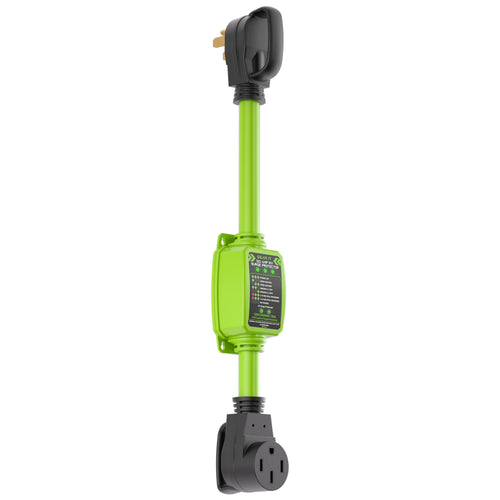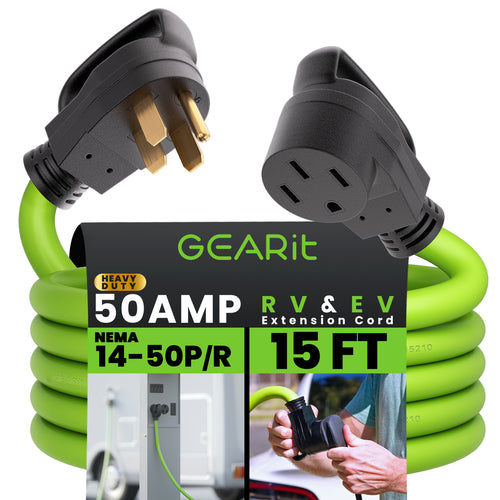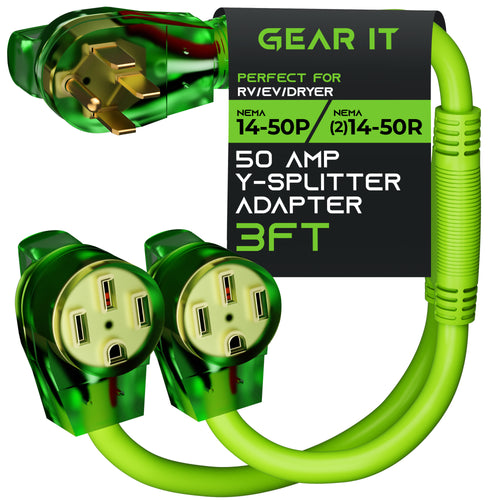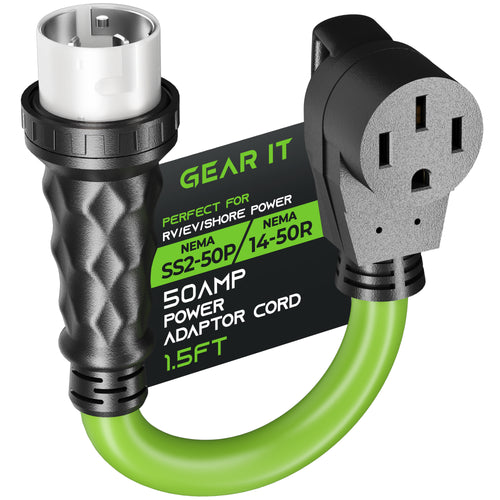For a 50-amp circuit, use 6 AWG wire for shorter distances and 4 AWG wire for longer runs to ensure safe and efficient power delivery. Choosing the correct wire size prevents overheating and ensures reliable performance.
Power up safely with GearIT’s top-rated 50 Amp cables and 4 AWG wires:
Shop GearIT now for durable, high-performance wiring solutions to keep your power systems running smoothly! ⚡🔌
Choosing the right wire size for a 50 amp circuit is essential for ensuring both safety and efficiency in your electrical setup. Using the correct wire gauge prevents overheating, reduces the risk of electrical fires, and ensures your circuit can handle the load without issues. Whether you're wiring for an RV, an appliance, or a home project, selecting the appropriate wire size is a critical step in the process.
In this guide, we’ll explain how to choose the right wire size for 50 amp circuits, covering important factors like wire gauge, material, and installation requirements. With the right information, you can confidently complete your project and maintain a safe electrical system.
Ensure reliable power for your RV with our durable 50 Amp RV power cords, designed for safe and efficient connections.
Understanding Wire Gauge and Ampacity

Selecting the appropriate wire size is essential for safety and efficiency in a 50-amp circuit. This section explains wire gauge concepts, the American Wire Gauge (AWG) standards, and how to accurately determine ampacity.
Basics of Wire Gauge
Wire gauge refers to the thickness of the wire, which directly affects its electrical resistance and current-carrying capacity. Thicker wires have lower resistance, allowing more current to flow without overheating.
The gauge number inversely represents the wire diameter; a lower gauge number indicates a thicker wire. For instance, a 6-gauge wire is thicker than an 8-gauge wire.
In practical applications, selecting the correct gauge size ensures that the wire can safely handle the load without excessive heat, which can cause insulation damage or fire hazards.
American Wire Gauge (AWG) Standards
The American Wire Gauge (AWG) system provides a standardized method to categorize wire sizes. Each gauge number corresponds to a specific diameter measured in thousandths of inches.
According to AWG standards, the #6 AWG copper wire can safely carry up to 50 amps. For aluminum wire, which has a higher resistance, a #4 AWG is typically recommended for the same amperage.
Using AWG helps ensure compliance with electrical codes, facilitating safe installation and operation. Reviewing the AWG chart allows you to easily identify the appropriate wire size for various applications.
Determining Ampacity
Ampacity refers to the maximum current a wire can carry safely under specific conditions. Factors influencing ampacity include the wire material, insulation type, and ambient temperature.
For a standard 50-amp circuit, the NEC suggests using a 6-gauge copper wire or 4-gauge aluminum wire. It's important to apply the 80% rule in practice—this means you should not exceed 80% of the wire’s rated capacity for continuous loads.
For a 50-amp circuit, this equates to a maximum safe load of 40 amps. Always ensure that you consider these factors when determining the right wire size to maintain safety and efficiency in your electrical installations.
Selecting Wire Size for a 50-Amp Circuit
Choosing the correct wire size for a 50-amp circuit is crucial for ensuring safety and efficiency. You will primarily consider whether to use copper or aluminum wiring, as well as specific gauges that are appropriate for your setup.
Copper Versus Aluminum Wiring
When selecting wire for a 50-amp circuit, you can choose between copper and aluminum. Copper wire is more conductive, which means it can handle the load more efficiently. It is generally preferred for smaller, residential applications due to its lower resistance and durability. For a 50-amp service, 6 AWG copper wire is typically adequate.
Aluminum wire is a more economical alternative but has higher resistance. To achieve the same conductivity, a larger gauge is necessary. For a 50-amp circuit using aluminum, 4 AWG wire is recommended. It’s essential to consider both cost and performance when deciding between these two materials.
Wire Size for 50-Amp Circuit Breakers
The National Electric Code (NEC) recommends using 6 AWG wire for copper and 4 AWG wire for aluminum in 50-amp circuits. These sizes help manage the current without overheating or causing voltage drops.
Applying the 80% rule for continuous loads is also important. This means that for a 50-amp breaker, you should ideally draw no more than 40 amps. Thus, using wire that can handle up to 62.5 amps is advisable, reinforcing the need for the correct gauge.
6 AWG Copper and Aluminum Wire Recommendations
For copper wiring, 6 AWG is your go-to choice for a 50-amp circuit. It can safely carry the necessary current and minimize the risk of overheating. This wire size is also compliant with various electrical codes, ensuring safety.
For aluminum wiring, you should opt for 4 AWG, as it compensates for aluminum's lower conductivity. Using the recommended sizes will help prevent excessive voltage drops over distance, particularly in longer runs. Always verify that the wire type matches your circuit requirements for optimal performance.
Power your generator with confidence. Explore our range of generator cords for dependable and high-quality performance.
National and Local Electrical Code Considerations
When working with 50 amp circuits, it’s essential to be aware of national and local electrical codes. These regulations ensure safety and compliance, helping to prevent electrical hazards such as fires and overheating. The following subsections outline important NEC requirements, local code variances, and safety standards.
NEC Code Requirements
The National Electrical Code (NEC) sets the foundation for electrical installations across the United States. For a 50 amp circuit, the NEC mandates the use of specific wire sizes: 6 AWG for copper and 4 AWG for aluminum. Adhering to these requirements helps ensure the circuit handles the expected load without overheating.
It’s crucial to note that the NEC includes guidelines for conductors, breakers, and overall system design. Ensure your installations align with Table 310.16 from the NEC, which details ampacity for various wire sizes. This is vital for maintaining safety and efficiency in electrical systems.
Local Building Code Variances
Local building codes can differ from NEC requirements, reflecting regional electrical standards. Always check with your local code enforcement office to identify any additional specifications or adjustments you may need. Local codes might implement stricter guidelines based on climate, historical building styles, or specific community safety concerns.
These variations can affect wire types, installation methods, and even the necessary amperage of circuits. It's essential to understand that compliance with both local and national codes is mandatory for both safety and legal reasons.
Safety Standards for Preventing Overheating and Electrical Fires
Safety standards are designed to minimize the risk of overheating and electrical fires. Proper wire sizing, as per NEC guidelines, is a fundamental aspect of preventing these hazards. Using undersized wire can lead to excessive heat buildup, which may ignite insulation or nearby materials.
In addition to wire size, ensure that connections and junction boxes are secure and accessible. Consider installing ground fault circuit interrupters (GFCIs) in moist areas and ensuring outlets are rated for the appliances they service. This proactive approach enhances safety and mitigates risks associated with electrical installations.
Voltage Drop and Wire Length
Understanding the relationship between voltage drop, wire length, and wire size is crucial for maintaining efficiency in your electrical systems. Proper calculations and selections will ensure that your electrical devices function optimally without risking damage or inefficiency.
Calculating Voltage Drops over Distance
Voltage drop occurs when electrical current travels through a wire, and it becomes more significant with increased wire length. The formula for calculating voltage drop (Vd) in a circuit is:
[ Vd = 1.73 \times K \times L \times I ]
Where:
- Vd = Voltage Drop
- K = Resistance in ohms for a circular mil foot of conductor
- L = One-way length of the circuit (feet)
- I = Current in conductor (amps)
For example, using 8 AWG wire, which has a resistance of about 0.6282 ohms per 1,000 feet, you can find the voltage drop for a 50 amp current over various lengths. Keeping this drop within acceptable limits is critical to ensure all connected devices function properly.
Choosing the Right Length for Efficiency
The length of your wire significantly impacts the efficiency of your electrical system. Longer wire runs result in higher resistance, leading to greater voltage drop. It’s essential to balance the wire length with the load it will carry.
For runs exceeding 100 feet, consider using a larger wire size to minimize voltage drop. If you are operating near the maximum load for your circuit (like in a 50 amp scenario), using a wire length longer than the recommended distance can lead to underperformance and equipment issues.
Referencing the NEC (National Electrical Code) guidelines can help determine ideal wire lengths based on the application.
When to Upsize Wire Gauge
You should upsize your wire gauge to counteract excessive voltage drop, especially for longer runs. If a voltage drop exceeds the acceptable limit, typically 3% for branch circuits, using a thicker wire is beneficial.
For a 50 amp application, if distances exceed 100 feet, consider upgrading to a lower gauge, such as 6 AWG instead of 8 AWG. This adjustment enhances conductivity and minimizes resistance, ensuring equipment receives enough voltage for proper operation.
Special Considerations for Specific Applications
When working with 50-amp circuits, various applications come with specific requirements. Whether you're wiring for a welder, setting up RV hookups, or connecting sub panels and dryer circuits, understanding these nuances is essential for safe and efficient operation.
Wiring for 50-Amp Welders
For 50-amp welders, using the correct wire size is critical to handle the electrical current effectively. Most recommendations suggest a 6 AWG copper wire or 4 AWG aluminum wire. This size ensures minimal voltage drop and prevents overheating during operation.
Additionally, consider your ambient temperature while selecting the wire. If the temperature exceeds the standard rating, you may need a larger gauge to maintain safety. A dedicated circuit breaker rated for 50 amps should be installed to protect the circuit, catering specifically to the welder’s needs.
Sizing for 50-Amp RV Hookups
When setting up 50-amp RV hookups, proper wire sizing is crucial for safety and performance. 6 AWG copper or 4 AWG aluminum wire is generally the standard. This ensures that your recreational vehicle receives adequate power without risking overheating.
You should also verify that your RV’s power cord is rated for 50 amps. Using a suitable circuit breaker with a 50-amp rating can safeguard against potential overloads. Ensure that all connections are secure to prevent electrical faults, particularly considering the dynamic conditions of traveling.
Sub Panels and Dryer Circuits
In sub panels and dryer circuits, attention to wire size and type can be critical. For a 50-amp sub panel, 6 AWG copper wire or 4 AWG aluminum wire is advisable. This is essential for accommodating the electrical current required for multiple circuits in the panel.
Dryers also demand specific circuit considerations. Using a 50 amp-rated dryer may require a separate circuit with adequate wire size. Check your dryer’s specifications for any additional requirements. Ensure that circuit breakers rated for the correct amperage are in place to provide protection against electrical faults.
Keep your electrical system grounded and secure. Browse our selection of ground wire to ensure optimal safety in all your installations.
Conclusion
Choosing the right wire size for a 50 amp circuit is vital for ensuring safety, efficiency, and proper functionality in any electrical setup. By understanding the importance of wire gauge, material, and installation requirements, you can prevent potential hazards and ensure your system runs smoothly. Whether you're working on an RV, generator, or home project, always prioritize safety and choose the correct wire size.
For more reliable power solutions, check out our full range of power products to find everything you need for your electrical setups.
Frequently Asked Questions
Will 6 gauge wire carry 50 amps?
Yes, a 6 gauge wire is designed to safely carry 50 amps without overheating. It meets the requirements set by electrical codes, making it a suitable choice for a 50 amp circuit.
What kind of wire do I need for a 50 amp car charger?
For a 50 amp car charger, you should use 6 AWG copper wire or 4 AWG aluminum wire. These sizes are adequate for handling the current without excessive voltage drop.
What size wire is needed for a 50 amp sub panel?
A 50 amp sub panel requires 6 AWG copper wire or 4 AWG aluminum wire. These sizes ensure safety and efficiency in power distribution.
How far will 4 gauge wire carry 50 amps?
4 gauge wire can carry 50 amps effectively over moderate distances. The specific distance will depend on the allowable voltage drop for your application, typically found in electrical code guidelines.
Will 8 gauge wire carry 50 amps?
No, 8 gauge wire is not suitable for carrying 50 amps. It generally has a current-carrying capacity of about 40 amps, which may lead to overheating if used for a 50 amp circuit.
How many amps will #8 wire carry?
#8 wire can typically carry up to 40 amps in most installations. This limit ensures that the wire operates within safe temperature parameters, reducing the risk of electrical hazards.























































